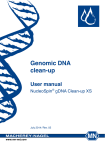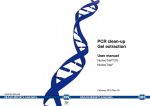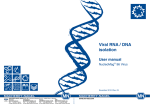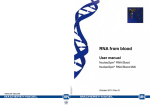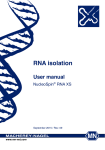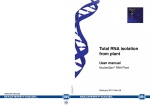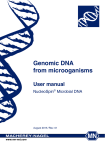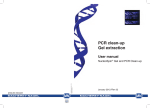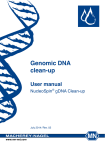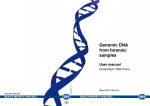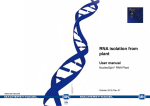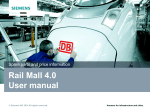Download Genomic DNA clean-up
Transcript
Genomic DNA clean-up User manual NucleoSpin® gDNA Clean-up XS May 2014 / Rev. 04 Genomic DNA clean-up Protocol-at-a-glance (Rev. 04) XS NucleoSpin gDNA Clean-up XS ® 1 Prepare sample 2 Adjust DNA binding conditions 3 Bind DNA Adjust up to 400 μL aqueous sample with buffer TE to 800 μL 200 μL NT Load 500 μL diluted sample 11,000 x g 30 s Load remaining sample 11,000 x g 30 s 4 Wash silica membrane Turn spin cup inside the centrifuge by 180° compared to the loading position 100 μL B5 11,000 x g 2 min 5 Elute DNA 1. 6–15 μL BE 11,000 x g 1 min 2. 6–15 μL BE 11,000 x g 1 min 6 Removal of residual ethanol and concentration 90 °C 8 min (2 x 10 μL elution) or 5 min (10 μL elution) MACHEREY-NAGEL GmbH & Co. KG · Neumann-Neander-Str. 6–8 · 52355 Düren · Germany Tel.: +49 24 21 969-270 · Fax: +49 24 21 969-199 · [email protected] · www.mn-net.com Genomic DNA clean-up Table of contents 1 Components 4 1.1 Kit contents 4 1.2 Reagents, consumables, and equipment to be supplied by user 5 1.3 About this user manual 5 2 Product description 6 2.1 Basic principle 6 2.2 Kit specifications 6 2.3 Handling of sample material 8 2.4 Elution procedures 8 2.5 Concentration and removal of residual ethanol 8 3 Storage conditions and preparation of working solutions 10 4 Safety instructions 11 4.1 Risk and safety phrases 11 4.2 GHS classification 11 5NucleoSpin® gDNA Clean-up XS protocol 6Appendix 12 14 6.1Troubleshooting 14 6.2 Ordering information 15 6.3 Product use restriction / warranty 15 MACHEREY-NAGEL – 05 / 2014, Rev. 04 3 Genomic DNA clean-up 1Components 1.1 Kit contents NucleoSpin® gDNA Clean-up XS 10 preps 50 preps 250 preps 740904.10 740904.50 740904.250 Binding Buffer NT 10 mL 25 mL 2 x 25 mL 1 x 10 mL Wash Buffer B5 (Concentrate)* 6 mL 6 mL 6 mL Elution Buffer BE** 5 mL 5 mL 15 mL NucleoSpin® gDNA Clean-up XS Columns (light green rings) 10 50 250 Collection Tubes (2 mL) 30 3 x 50 3 x 250 User manual 1 1 1 REF * For preparation of working solutions and storage conditions see section 3. **Composition of Elution Buffer BE: 5 mM Tris/HCl, pH 8.5 4 MACHEREY-NAGEL – 05 / 2014, Rev. 04 Genomic DNA clean-up 1.2 Reagents, consumables, and equipment to be supplied by user Reagents • • 96–100 % ethanol Buffer TE (e.g., 10 mM Tris/HCl pH 7.5, 0.1 mM EDTA) Consumables • • 1.5 mL microcentrifuge tubes (for sample lysis and DNA elution) Disposable pipette tips Equipment • Manual pipettors • Centrifuge for microcentrifuge tubes • • Thermal heating block Personal protection equipment (lab coat, gloves, goggles) 1.3 About this user manual It is strongly recommended that first-time users of the NucleoSpin® gDNA Cleanup XS kit read the detailed protocol sections of this user manual. Experienced users, however, may refer to the Protocol-at-a-glance instead. The Protocol-at-a-glance is designed to be used only as a supplemental tool for quick referencing while performing the purification procedure. All technical literature is available on the internet at www.mn-net.com. MACHEREY-NAGEL – 05 / 2014, Rev. 04 5 Genomic DNA clean-up 2 Product description 2.1 Basic principle The NucleoSpin® gDNA Clean-up XS kit is designed for a fast and convenient purification of genomic DNA from aqueous samples (e.g., phenol / chloroform extracts). PCR inhibitors (e.g., indigo) are efficiently removed and DNA is concentrated with high recovery. Due to its high sensitivity the kit is particularly well suited for trace levels of DNA from forensic samples. The optimized protocol allows for up to 400 μL of aqueous sample to be processed without the need for error-prone repeated loading steps. However, multiple loading steps can be used without difficulty to process larger sample volumes. The special funnel design of the thrust rings inside the NucleoSpin® gDNA Clean-up XS Column in combination with the very small membrane allows for high recovery with very small elution volumes (5–30 μL) which results in highly concentrated DNA. Appropriate conditions under which DNA binds to the silica membrane are created by addition of Binding Buffer NT. The mixture is then applied to the NucleoSpin® gDNA Clean-up XS Column and the DNA binds to a silica membrane. A subsequent washing step efficiently removes contaminations and highly pure DNA is finally eluted with 5–30 μL of a slightly alkaline elution buffer of low ionic strength (5 mM Tris/HCl pH 8.5). 2.2 Kit specifications 6 • The NucleoSpin® gDNA Clean-up XS kit is recommended for the purification and concentration of genomic DNA from very dilute aqueous samples. Typical sample materials comprise for example PCR inhibitor containing solutions, Proteinase K reaction mixtures, or the aqueous phase of phenol / chloroform extractions. • The robust membrane allows for multiple loading steps to process even large sample volumes. • The special column design and the very small membrane lead to a significantly reduced dead volume which allows for high recovery of small amounts of DNA with as little as 5–30 μL elution buffer. • DNA is ready-to-use for all common downstream applications like (e.g., realtime PCR). • The preparation time is approximately 20 min for 6–12 samples. MACHEREY-NAGEL – 05 / 2014, Rev. 04 Genomic DNA clean-up Table 1: Kit specifications at a glance Parameter NucleoSpin® gDNA Clean-up XS Sample material < 400 μL solution containing < 2 μg DNA Typical recovery 60–70 % Fragment size 100 bp–approx. 50 kbp A260/A280 1.8–1.9 Elution volume 6–15 μL Preparation time 20 min/6 preps (exclusive preceding extraction or lysis) Format Mini spin column – XS design • Forensic quality product: NucleoSpin® gDNA Clean-up XS is certified as forensic quality product. Consumables used in forensics need to be treated carefully to prevent DNA contamination. MACHEREY-NAGEL therefore has a stringently controlled production process to avoid DNA contamination of consumables. Further, MACHEREY-NAGEL uses ethylene oxide (EO) treatment to remove amplifiable DNA, which might still be introduced during the manufacturing process. MACHEREY-NAGEL products carrying the forensic quality seal, contain plastic materials that are EO treated. This means, DNA of any kind, which might still be introduced into plastic consumables during the production process, is inactivated by means of the treatment with ethylene oxide, in order to prevent the generation of accidental human profile by PCR amplification. Ethylene oxide treatment has been shown to be the method of choice to prevent DNA profiles due to DNA contamination (Shaw et al. 2008; Figure 1). UV Gamma 100% 30% 40% 30% Full profile Electron beam Partial profile (loadable) 27% Ethylene oxide 3% 13% 87% 70% Partial profile (unloadable) No profile Figure 1: According to Shaw et al., 2008, Comparison of the effects of sterilization techniques on subsequent DNA profiling. Int J Legal Med 122: 29-33. MACHEREY-NAGEL – 05 / 2014, Rev. 04 7 Genomic DNA clean-up 2.3 Handling of sample material The NucleoSpin® gDNA Clean-up XS procedure is designed for very small amounts of genomic DNA and the typical downstream applications are thus very sensitive. It is consequently highly recommended to perform sampling and DNA purification with special care, in order to avoid a contamination of the sample or the purified DNA with unwanted DNA-containing material (e.g., fingerprints, hair particles, aerosol, dust). Moreover, a cross-contamination between samples has to be excluded. The following precautions are recommended: • Wear personal protection equipment (lab coat, gloves, goggles). • Always change pipette tips between liquid transfers. • • Use aerosol resistant pipette tips. Briefly centrifuge after mixing steps in order to remove droplets from tube lid. 2.4 Elution procedures A high DNA concentration in the elution fraction is of importance and desirable for all typical downstream applications. This is of particular interest if the total volume of a reaction mixture is limited as this in turn limits the possible amount of DNA that can be added. Due to a high default elution volume, classical DNA clean-up kits often result in weakly concentrated DNA, if only small amounts of DNA are processed. Such DNA may even require a subsequent concentration before it can be used for typical downstream applications. In contrast to classical kits, NucleoSpin® gDNA Clean-up XS allows for efficient elution in a very small volume which results in highly concentrated DNA. For forensic samples elution with 2 x 6 μL is recommended to maximize concentration and yield. A two-fold elution generally yields more DNA than just one elution with the same total buffer volume. Optionally, the second elution can be omitted to achieve the highest possible DNA concentration. In general, larger volumes (10–30 μL) increase the overall DNA yield but naturally reduce the final DNA concentration. Elution buffer volumes > 30 μL will only slightly increase total DNA yield. 2.5 Concentration and removal of residual ethanol For most applications removal of trace levels of ethanol is not required. However, if a large volume of eluate has to be used as PCR template a heat incubation of the eluate is recommended. An incubation of for example 8 min at 90 °C for a 20 μL eluate removes residual ethanol in the eluate and concentrates the DNA to approximately 11 μL resulting in a significantly increased sensitivity in downstream applications. 8 MACHEREY-NAGEL – 05 / 2014, Rev. 04 Genomic DNA clean-up The template may then represent up to 40 % of the total PCR reaction volume. The necessity of this step may be individually tested. An incubation at 90 °C, however, will denature DNA. If non-denatured DNA is required for downstream applications other than PCR (e.g., ligation or cloning) we recommend an incubation of 17 min at 75 °C to remove ethanol from an eluate of 20 μL. Incubation [min] Even if ethanol is of no concern for the downstream application the heat incubation is a useful means to concentrate an eluate. Use Figure 2 to estimate the necessary incubation time depending on your elution volume and the intended final volume. Take into consideration that incubation times may vary depending on the heating block or microcentrifuge tubes that are used. Shaking the tubes during incubation increases the evaporation rate even more. 40 38 36 34 32 30 28 26 24 22 20 18 16 14 12 10 8 6 4 2 0 5 10 15 20 25 30 Volume [µL] 70°C - - - - - - 90°C Figure 2: Concentration and removal of residual ethanol from eluates by heat treatment. Eluates of 10, 20, and 30 μL were incubated at 75 °C (non-denaturing) and 90 °C (denaturing) for 0–40 min without shaking. Choose your final volume and read the necessary incubation time from the appropriate curve. For other starting volumes just interpolate the array of curves. MACHEREY-NAGEL – 05 / 2014, Rev. 04 9 Genomic DNA clean-up 3 Storage conditions and preparation of working solutions Attention: Buffer NT contains guanidinium thiocyanate. Wear gloves and goggles! Storage conditions: • All kit components can be stored at room temperature (18–25 °C) and are stable for at least one year. Before starting any NucleoSpin® gDNA Clean-up XS protocol prepare the following: • Wash Buffer B5: Add the indicated volume of ethanol (96–100 %) to Buffer B5 Concentrate. Mark the label of the bottle to indicate that ethanol was added. Wash Buffer B5 can be stored at room temperature (18–25 °C) for at least one year. NucleoSpin® gDNA Clean-up XS 10 preps 50 preps 250 preps REF 740904.10 740904.50 740904.250 Wash Buffer B5 (Concentrate) 6 mL Add 24 mL ethanol 6 mL Add 24 mL ethanol 6 mL Add 24 mL ethanol 10 MACHEREY-NAGEL – 05 / 2014, Rev. 04 Genomic DNA clean-up 4 Safety instructions The following components of the NucleoSpin® gDNA Clean-up XS kits contain hazardous contents. Wear gloves and goggles and follow the safety instructions given in this section. 4.1 Risk and safety phrases Component Hazard contents Inhalt Gefahrstoff NT Guanidinium thiocyanate Guanidinthiocyanat Hazard symbol Risk phrases Gefahrstoffsymbol Xn* Safety phrases R-Sätze S-Sätze R 20/21/22 S 13 Risk phrases R 20/21/22 Harmful by inhalation, in contact with skin, and if swallowed. Gesundheitsschädlich beim Einatmen, Verschlucken und Berührung mit der Haut. Safety phrases S 13 Keep away from food, drink, and animal feedstuffs. Von Nahrungsmitteln, Getränken und Futtermitteln fernhalten. 4.2 GHS classification Only harmful features must not be labeled with H and P phrases until 125 mL or 125 g. Mindergefährliche Eigenschaften müssen bis 125 mL oder 125 g nicht mit H- und P-Sätzen gekennzeichnet werden. Component Hazard contents GHS symbol Inhalt Gefahrstoff GHS Symbol NT Guanidinium thiocyanate 30–60 % Guanidinthiocyanat 30–60 % Hazard phrases H-Sätze Precaution phrases P-Sätze Warning Achtung For further information please see Material Safety Data Sheets (www.mn-net.com). Weiterführende Informationen finden Sie in den Sicherheitsdatenblättern (www.mn-net.com). The symbol shown on labels refers to the precaution phrases of this section. Das auf Etiketten dargestellte Symbol weist auf die P-Sätzen dieses Kapitels hin. * Hazard labeling not necessary if quantity per bottle below 125 g or mL (certificate of exemption according to 67/548/EEC Art. 25, 1999/45/EC Art. 12 and German GefStoffV § 20 (3) and TRGS 200 7.1). For further information see Material Safety Data Sheet. MACHEREY-NAGEL – 05 / 2014, Rev. 04 11 NucleoSpin® gDNA Clean-up XS 5NucleoSpin® gDNA Clean-up XS protocol Before starting the preparation: • • 1 Check if Wash Buffer B5 was prepared according to section 3. Prepare buffer TE (e.g., 10 mM Tris/HCl pH 7.5, 0.1 mM EDTA) Prepare sample Note: The following dilution step with TE buffer might not be necessary for highly concentrated samples, for uncomplicated pre-purified DNA, or non-forensic samples. For < 400 μL sample solution, dilute with buffer TE (not provided) to a final volume of 800 μL. For > 400 μL sample solution, add 1 vol of buffer TE and increase Buffer NT proportionally in step 2. + TE to a final volume of 800 μL Mix thoroughly by vortexing and spin down briefly to clear the lid. 2 Adjust DNA binding conditions Add 200 μL Buffer NT per 800 μL diluted or undiluted sample (e.g., add 100 μL Buffer NT to 400 μL sample). Mix thoroughly by vortexing. Spin down briefly to clear the lid. 3 Bind DNA For each sample, place one NucleoSpin® gDNA Cleanup XS Column into a Collection Tube (2 mL). Add 500 μL of binding mixture to the column. Centrifuge for 30 s at 11,000 x g and discard the flow-through. Add the remaining binding mixture to the column and centrifuge for 30 s at 11,000 x g. Place the column into a new Collection Tube (2 mL). 12 MACHEREY-NAGEL – 05 / 2014, Rev. 04 + 200 μL NT per 800 μL of sample Load 500 μL sample 11,000 x g 30 s Load remaining sample 11,000 x g 30 s NucleoSpin® gDNA Clean-up XS 4 Wash silica membrane Turn the NucleoSpin® gDNA Clean-up XS Column inside the centrifuge by 180° compared to the loading position in order to allow optimal washing efficiency. Add 100 μL Buffer B5. + 100 μL B5 11,000 x g 2 min Centrifuge for 2 min at 11,000 x g. 5 Elute DNA Place the NucleoSpin® gDNA Clean-up XS Column into a 1.5 mL microcentrifuge tube (not supplied). Add 6–15 μL Buffer BE directly to the center of the membrane. Centrifuge for 1 min at 11,000 x g. Add another 6–15 μL Buffer BE directly to the center of the membrane. Centrifuge for 1 min at 11,000 x g. Note: The elution volume can be varied from 5–30 μL. The second elution step can be omitted leading to higher concentration but lower yield. See section 2.4 for more information. 6 Removal of residual ethanol and concentration Incubate eluate with open lid at 90 °C for 8 min (2 x 10 μL elution) or 5 min (10 μL elution). Note: For different elution volumes or incubation at 75 °C for non-denatured DNA see section 2.5 for detailed information. MACHEREY-NAGEL – 05 / 2014, Rev. 04 + 6–15 μL BE 11,000 x g 1 min + 6–15 μL BE 11,000 x g 1 min 90 °C, 8 min (2 x 10 μL elution) or 90 °C, 5 min (10 μL elution) 13 Genomic DNA clean-up 6Appendix 6.1Troubleshooting Problem Possible cause and suggestions fReagents not prepared properly Low DNA yield • Add the indicated volume of 96–100 % ethanol to the Buffer B5 Concentrate and mix well before use. Residual ethanol in eluate • No increase of PCR signal despite an increased volume of eluate used as template Please see the detailed description of removal of residual traces of ethanol in section 2.5. Carry-over of chaotropic salts • Perform a second washing step with Buffer B5 to remove last traces of Buffer NT. Silica abrasion from the membrane • Discrepancy between A260 quantification values and PCR quantification values Due to the typically low DNA content in very small samples and the resulting low total amount of isolated DNA, DNA quantification via A260 absorption measurement is often hampered by the low sensitivity of this method. When performing absorption measurements close to the detection limit of the photometer, the measurement may be influenced by minor amounts of silica abrasion. In order to prevent incorrect A260 quantification of small DNA amounts centrifuge the eluate for 30 s at > 11,000 x g and take an aliquot for measurement without disturbing any sediment. Alternatively, use a silica abrasion insensitive DNA quantification method (e.g., PicoGreen® fluorescent dye). Measurement not in the range of photometer detection limit A260/A280 ratio high or too low 14 too • In order to obtain a significant A260/A280 ratio it is necessary that the initially measured A260 and A280 values are significantly above the detection limit of the photometer used. An A280 value close to the background noise of the photometer will cause unexpected A260/ A280 ratios. MACHEREY-NAGEL – 05 / 2014, Rev. 04 Genomic DNA clean-up 6.2 Ordering information Product REF ® Pack of NucleoSpin gDNA Clean-up XS 740904.10 740904.50 740904.250 10 preps 50 preps 250 preps NucleoSpin® gDNA Clean-up 740230.10 740230.50 740230.250 10 preps 50 preps 250 preps Buffer NT 740614.100 100 mL Buffer B5 (Concentrate) 740921 20 mL Buffer BE 740306.100 100 mL Collection Tubes (2 mL) 740600 (for 100 mL Buffer B5) 1000 Visit www.mn-net.com for more detailed product information. 6.3 Product use restriction / warranty NucleoSpin® gDNA Clean-up XS kit components are intended, developed, designed, and sold FOR RESEARCH PURPOSES ONLY, except, however, any other function of the product being expressly described in original MACHEREY-NAGEL product leaflets. MACHEREY-NAGEL products are intended for GENERAL LABORATORY USE ONLY! MACHEREY-NAGEL products are suited for QUALIFIED PERSONNEL ONLY! MACHEREY-NAGEL products shall in any event only be used wearing adequate PROTECTIVE CLOTHING. For detailed information please refer to the respective Material Safety Data Sheet of the product! MACHEREY-NAGEL products shall exclusively be used in an ADEQUATE TEST ENVIRONMENT. MACHEREY-NAGEL does not assume any responsibility for damages due to improper application of our products in other fields of application. Application on the human body is STRICTLY FORBIDDEN. The respective user is liable for any and all damages resulting from such application. DNA/RNA/PROTEIN purification products of MACHEREY-NAGEL are suitable for IN VITRO-USES ONLY! ONLY MACHEREY-NAGEL products specially labeled as IVD are also suitable for IN VITRO-diagnostic use. Please pay attention to the package of the product. IN VITROdiagnostic products are expressly marked as IVD on the packaging. IF THERE IS NO IVD SIGN, THE PRODUCT SHALL NOT BE SUITABLE FOR IN VITRO-DIAGNOSTIC USE! MACHEREY-NAGEL – 05 / 2014, Rev. 04 15 Genomic DNA clean-up ALL OTHER PRODUCTS NOT LABELED AS IVD ARE NOT SUITED FOR ANY CLINICAL USE (INCLUDING, BUT NOT LIMITED TO DIAGNOSTIC, THERAPEUTIC AND/OR PROGNOSTIC USE). No claim or representations is intended for its use to identify any specific organism or for clinical use (included, but not limited to diagnostic, prognostic, therapeutic, or blood banking). It is rather in the responsibility of the user or - in any case of resale of the products - in the responsibility of the reseller to inspect and assure the use of the DNA/RNA/protein purification products of MACHEREY-NAGEL for a well-defined and specific application. MACHEREY-NAGEL shall only be responsible for the product specifications and the performance range of MN products according to the specifications of in-house quality control, product documentation and marketing material. This MACHEREY-NAGEL product is shipped with documentation stating specifications and other technical information. MACHEREY-NAGEL warrants to meet the stated specifications. MACHEREY-NAGEL´s sole obligation and the customer´s sole remedy is limited to replacement of products free of charge in the event products fail to perform as warranted. Supplementary reference is made to the general business terms and conditions of MACHEREY-NAGEL, which are printed on the price list. Please contact us if you wish to get an extra copy. There is no warranty for and MACHEREY-NAGEL is not liable for damages or defects arising in shipping and handling (transport insurance for customers excluded), or out of accident or improper or abnormal use of this product; defects in products or components not manufactured by MACHEREY-NAGEL, or damages resulting from such non-MACHEREY-NAGEL components or products. MACHEREY-NAGEL makes no other warranty of any kind whatsoever, and SPECIFICALLY DISCLAIMS AND EXCLUDES ALL OTHER WARRANTIES OF ANY KIND OR NATURE WHATSOEVER, DIRECTLY OR INDIRECTLY, EXPRESS OR IMPLIED, INCLUDING, WITHOUT LIMITATION, AS TO THE SUITABILITY, REPRODUCTIVITY, DURABILITY, FITNESS FOR A PARTICULAR PURPOSE OR USE, MERCHANTABILITY, CONDITION, OR ANY OTHER MATTER WITH RESPECT TO MACHEREY-NAGEL PRODUCTS. In no event shall MACHEREY-NAGEL be liable for claims for any other damages, whether direct, indirect, incidental, compensatory, foreseeable, consequential, or special (including but not limited to loss of use, revenue or profit), whether based upon warranty, contract, tort (including negligence) or strict liability arising in connection with the sale or the failure of MACHEREY-NAGEL products to perform in accordance with the stated specifications. This warranty is exclusive and MACHEREY-NAGEL makes no other warranty expressed or implied. The warranty provided herein and the data, specifications and descriptions of this MACHEREY-NAGEL product appearing in MACHEREY-NAGEL published catalogues and product literature are MACHEREY-NAGEL´s sole representations concerning the product and warranty. No other statements or representations, written or oral, by MACHEREY-NAGEL´s employees, agent or representatives, except written statements signed by a duly authorized officer of MACHEREY-NAGEL are authorized; they should not be relied upon by the customer and are not a part of the contract of sale or of this warranty. 16 MACHEREY-NAGEL – 05 / 2014, Rev. 04 Genomic DNA clean-up Product claims are subject to change. Therefore please contact our Technical Service Team for the most up-to-date information on MACHEREY-NAGEL products. You may also contact your local distributor for general scientific information. Applications mentioned in MACHEREY-NAGEL literature are provided for informational purposes only. MACHEREY-NAGEL does not warrant that all applications have been tested in MACHEREY-NAGEL laboratories using MACHEREY-NAGEL products. MACHEREYNAGEL does not warrant the correctness of any of those applications. Last updated: 07 / 2010, Rev. 03 Please contact: MACHEREY-NAGEL GmbH & Co. KG Tel.: +49 24 21 969-270 [email protected] Trademarks: NucleoSpin® is a trademark of MACHEREY-NAGEL GmbH & Co KG PicoGreen® is a registered trademark of Molecular Probes, Inc. All used names and denotations can be brands, trademarks, or registered labels of their respective owner – also if they are not special denotation. To mention products and brands is only a kind of information (i.e., it does not offend against trademarks and brands and can not be seen as a kind of recommendation or assessment). Regarding these products or services we can not grant any guarantees regarding selection, efficiency, or operation. MACHEREY-NAGEL – 05 / 2014, Rev. 04 17

















